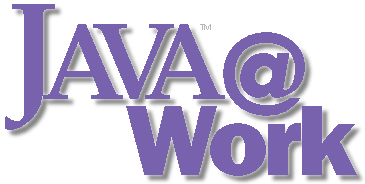

Getting started
with Java
National Semiconductor, located in Santa Clara, Calif., expects the Web site to increase demand for its products by allowing the company to reach a much broader audience than it could before, especially engineers overseas. Also, by making information about its components easier to come by, National Semiconductor believes product designers will be more likely to specify its products over a competitor's.

Visit National Semiconductor
Up-to-Date Information
Now, design engineers with Web access can download information about any of National Semiconductor's 30,000 products, 24 hours a day from anywhere in the world. More importantly, they can find the information they need quickly and easily, which company officials realized would be critical to the success of the Web site.
"We knew that our product data books and CD-ROMs weren't reaching our entire target audience, the approximately one million engineers who incorporate electronic components into their products," says Schulman. "But as a solution, the Web was not a given. Our market research told us that if it took people more than three minutes to find information from a Web site, they wouldn't use it."

A datasheet example
To make this kind of fast, interactive search possible, National Semiconductor contacted CADIS Inc., a Boulder, Colorado-based company with experience in the field of parts information management. At the time, the summer of 1995, CADIS had installed its software solution in a number of large manufacturing organizations including General Electric, Ingersoll-Rand, Tektronix, and 3M. CADIS' technology, which had nothing to do with the Web at that point, was being used in these companies to classify and retrieve information from huge parts databases, primarily to make sure engineers located existing parts and reused them, rather than spending time and money to re-create them.
Cadis' home page
CADIS started working on the project right away. The core technology -- an object-oriented database that supported client-server computing -- was there, but for the Web the company wanted to carry over what it calls a guided, iterative search. That meant providing feedback on the number of products that qualify for users as they navigated down through a series of file folders. On National Semiconductor's Web site, the folders start with broad categories of electronic components such as communications devices, memory chips, microprocessors, and so on. These folders open up to other folders that describe various sub-classes of components, which open up to other folders, and so on until the search is narrowed systematically and a desired component is located.

CADIS Java and HTML search demos
This is where the Web project got complicated. Providing that kind of interactive feedback via the Web was possible, but slow using a search engine written in the HTML language typical of Web programs at the time.
"The problem with HTML is that it works page-to-page," explains Eden-Harris. "It makes up a page and downloads it, and the next time the user does something, it makes up another page and downloads it." With this type of search, National Semiconductor customers would be unlikely to find the information they needed in less than three minutes.

More on JAVA
"We had to make sacrifices to get reasonable performance with an HTML-based search system," added Eden-Harris. "The system had to assemble the user selections on an HTML form, then launch it as a single query, rather than interactively communicating with the server to update each step of the query. Fortunately, we found out about Java and immediately felt it would be the solution for this type of Web search. Java gave us the opportunity to create a whole new product for the Web from our existing technology."
In three weeks, CADIS rewrote its parts management system in Java, the programming language from Sun Microsystems that has been said to "turn the Internet into a giant disk drive." (Business Week, 12/4/94, p. 81) To create the working prototype, CADIS not only developed the client application in Java, it also wrote the needed Java Remote Procedure Calls that allowed immediate updates between the user and the Web server. This gave the search engine the ability to instantly update such things as part counts and associated screens while users navigated through the folders.

SPARCserver 1000
Once users identify desired components, CADIS Krakatoa also lets users request additional information such as product data sheets. From the Web server in Santa Clara, a Sun Microsystems SPARCserver(tm) 1000 that houses Krakatoa and the parts database, a request for a data sheet goes back out to Internet to a service called Web Direct hosted at R.R. Donnelley in Chicago. That's where the National Semiconductor data sheets are housed. Depending on the number of data sheets requested, downloading them might take more than three minutes, but according to Eden-Harris, that is all right.
R. R. Donnelley & Sons ONLINE
Using Java, CADIS has given National Semiconductor a Web site that acts more like a client-server computer than an Internet application. That is, the site has the feel of searching a database across the hall rather than across the country or on the other side of the world. As one of the first commercial applications of Java, the National Semiconductor site using Krakatoa is the beginning of truly useful application on the Web.
Says Eden-Harris, "We think that over time, as a result of efforts like National Semiconductor's, engineers will come to see the Web as the preferred place to get product information. Compared to printed matter or even CD-ROMs that can be obsolete almost as soon as they're produced, whatever they find at a Web site will be far more accurate, complete, and current."


 http://www.sun.com/960301/feature3/index.html (PC Press Internet CD, 03/1996)
http://www.sun.com/960301/feature3/index.html (PC Press Internet CD, 03/1996)